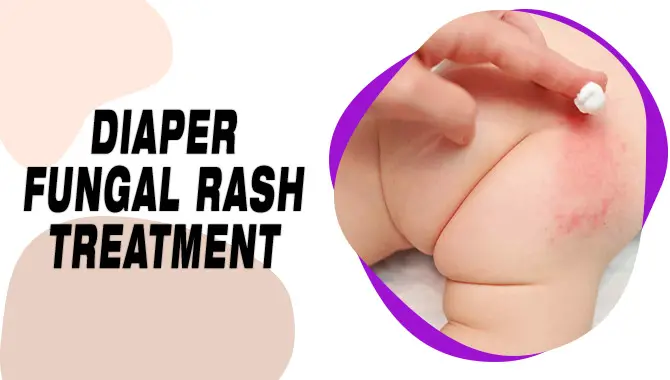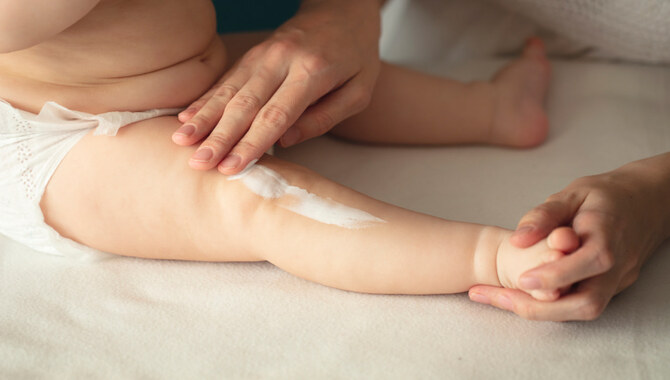Fungal or diaper rashes are painful pink or red patches that develop on your baby’s diaper area. These rashes can be caused by various skin conditions, including thrush and yeast infections.
But they’re often the result of a dirty diaper. You strive to give your newborn everything they need to be healthy, happy, and comfortable. However, despite the best intentions, diaper rashes are common, and a diaper fungal rash treatment can worsen things.
Fungal diaper rashes often start as mild irritation but can quickly become painful. Making it difficult for your little one to sit, lie, or even sleep. We will cover everything you need to know to control your baby’s diaper rash.
From understanding what a diaper fungal rash is and how it forms to five effective ways to treat it, including home remedies and topical ointments. We will also provide prevention tips to help you avoid diaper fungal rashes in the future.

What Is A Diaper Fungal Rash?
A diaper fungal rash, also known as a yeast diaper rash, is a skin problem that develops in the area under an infant’s diaper. The candida fungus is responsible for causing a yeast diaper rash that can cause softening, redness, and breakdown of the tissue around the anus.
You may also observe elevated skin, and fluid may be visible under the skin. The rash can be intensely itchy due to an imbalance of healthy bacteria and yeast. Contributing factors can include urine and stool acidity, chronic wetness, and friction from the diaper.
It is essential to treat it promptly with antifungal creams or ointments, avoid baby powder, and follow proper cleaning and changing procedures during diapering. Additionally, increasing airflow to the butt’s area during diaper usage, changing brands of diapers, and improving dietary habits can help with treatment.
5 Effective Ways Diaper Fungal Rash Treatment

There are many effective ways to treat diaper fungal rash. Antifungal creams like Nystatin, clotrimazole, and miconazole targeting irritants and fungus can work wonders for yeast infections. Parents should also try home remedies such as keeping the affected skin dry and changing diapers more frequently to reduce symptoms.
Applying a barrier cream such as petroleum jelly can help to protect the skin and lessen the irritation. If you are suffering from diaper rash, contact a doctor immediately. The condition can be potentially serious and requires prompt medical attention. Here are 5 effective ways to treat diaper rash with care:
- Wash your baby’s clothes frequently: Washing clothes worn by your baby frequently helps to prevent the spread of fungus and germs. You can remove any fungus on the clothing by washing them in hot water.
- Use medicated cream or ointment: Using medicated cream or ointment on your baby’s skin can help control the inflammation and irritation caused by diaper rash. You can also consult a doctor for further recommendations if the condition worsens.
- Avoid non-organic materials: Using non-organic materials such as synthetic diapers, wet wipes, and detergents can increase babies’ risk of diaper rashes. Therefore, using organic materials like cotton, hemp, and wool is important when cleaning your child’s clothes.
- Apply heat therapy: Applying heat therapy on your baby’s skin can help reduce inflammation and redness caused by diaper rash. You can do this by using a heating pad or warm mist humidifier to soothe the itchy skin of your baby.
- Avoid wearing diapers for too long: It is essential to keep track of how long you wear diapers so they don’t become overgrown with the fungus causing diaper rash in your baby’s bottom region (anus).
What Is Diaper Fungal Rash, And How Does It Form?
Diaper fungal rash, also known as yeast diaper rash, is a common condition caused by a fungal infection on the skin around a baby’s diaper area. The fungus Candida albicans thrives in warm, moist environments like the one created by a diaper.
Infants and toddlers are more susceptible to this type of rash because of the chronic wetness and acidity in their urine and stool. Yeast diaper rash manifests as a red rash around the anus, with fluid visible beneath the skin and small, raised, infected red bumps surrounding the rash.
In addition to fungal infections, diaper rash can occur due to skin irritation from wetness, friction from the diaper, or a bacterial skin infection. Prompt treatment can help prevent the rash from worsening and improve your baby’s comfort.
Effective Home Remedies For Diaper Fungal Rash

Diaper fungal rash is a common problem among babies, causing irritation and discomfort. Some effective home remedies can provide instant relief from diaper rash. Witch hazel and breast milk are effective natural remedies to soothe diaper rash. Keeping the skin clean and dry is the best treatment for diaper rash. Changing diapers frequently and allowing the skin to air-dry can help reduce the irritation.
Avoiding harsh diaper wipes, using warm water with mild soap, and applying ointments like Aquaphor or Vaseline can also alleviate symptoms. Parents can also consider natural alternatives for conventional products. A soothing bath and applying ointment in older children can help soothe diaper rash. Remember that if the rash persists or worsens, it is essential to consult a pediatrician.
Fungal Rash Treatment Using Topical Ointments And Creams

Fungal diaper rashes are common and require antifungal creams for effective treatment. Available in pharmacies, over-the-counter antifungal creams, such as clotrimazole, miconazole, and Nystatin, can be used. These creams prevent the growth of fungi and speed up the healing process. You should apply topical ointments or creams at each diaper change until the rash heals completely.
Prescription antifungal creams, like econazole or ketoconazole, may be required if the rash is severe, extensive, or not responding to over-the-counter creams. Cool water compresses, and topical steroids can be used to relieve the symptoms of contact dermatitis, like itching and inflammation.
Decreasing moisture in the diaper area by frequently changing diapers or using moisture-absorbing powders like talcum is also recommended. Following the right treatment method is essential to cure diaper rashes completely.
Prevention Tips To Avoid Diaper Fungal Rashes

Prevention is always better than cure, and it’s the same for diaper fungal rashes. Parents should change their babies’ diapers after becoming wet or soiled as soon as possible. Checking the diaper every two hours and getting the baby in a clean diaper or incontinence briefs at least eight times every 24 hours can help prevent diaper fungal rash.
Let the affected area breathe for a few minutes after each diaper change. You must wash cloth diapers and incontinence briefs with mild detergents and rinse twice; avoid bleach and fabric softeners if possible. In case of diarrhea, using a cream containing zinc oxide or A&D ointment, or Desitin, can protect the baby’s skin. Parents can significantly reduce the likelihood of their baby developing a diaper fungal rash by taking these preventative measures.
Conclusion
Diaper fungal rash is a common issue that parents face, and it can be quite distressing for both the baby and the parent. Understanding what causes a diaper fungal rash and how to avoid it is essential, as prevention is always better than cure. Several effective treatment options include home remedies, topical ointments, and creams.
Maintaining good hygiene practices, such as keeping the diaper area dry and clean and using the right products to avoid diaper fungal rash, is crucial. If you’re suffering from a diaper fungal rash, getting treatment as soon as possible is important.
Many treatments are available, and the best one for you will depend on the specifics of your case. We have discussed the different types of diaper fungal rashes and their treatments. We have also provided helpful tips on identifying and diaper fungal rash treatment. By following a few simple tips, you can help reduce the rash’s severity and duration while preventing it from returning in the future.
Frequently Asked Questions
What Antifungal Cream Is Best For Diaper Rash?
It is best to consult a pediatrician or a dermatologist for specific recommendations on antifungal creams for diaper rash. They can assess the severity of the rash and prescribe the most appropriate treatment for your baby’s needs. However, common antifungal creams used for diaper rash include clotrimazole and miconazole. Always carefully follow the instructions provided by your healthcare provider and the product labeling.
How Long Does It Take For A Fungal Diaper Rash To Go Away?
The length of time it takes for a fungal diaper rash to go away can vary depending on the severity of the rash and the treatment used. Most fungal diaper rashes should improve with proper treatment within a few days to a week.
However, continuing the prescribed treatments for the recommended length is important to ensure the rash is fully cleared and prevent it from returning. If the rash does not improve or worsens, it is best to consult a healthcare provider.
How Do I Know If My Diaper Rash Is Fungal?
If a fungal infection causes your diaper rash, you may notice redness, scaling, and itching in the affected area. The rash may also have well-defined borders and small red bumps or pimples. Additionally, the rash may persist despite typical diaper rashes treatments, such as diaper creams or frequent diaper changes. If you suspect a fungal infection is causing your diaper rash, it is best to consult with a healthcare professional for diagnosis and treatment recommendations.
How Do You Treat Fungal Diaper Rash Naturally?
Natural remedies for treating fungal diaper rash include coconut oil, tea tree oil, and apple cider vinegar. Applying coconut oil to the affected area can help soothe the skin and fight off the fungus. Tea tree oil has antifungal properties that can help kill the fungus causing the rash. Diluted apple cider vinegar can also effectively reduce inflammation and treat the rash.
What Are Some Common Causes Of Diaper Fungal Rash?
Some common causes of diaper fungal rash include prolonged skin contact with moisture, use of antibiotics, weakened immune system, and wearing tight-fitting or non-breathable diapers. Fungal infections such as candida can also be a cause of diaper rash.
Changing the diaper frequently, using a barrier cream, and keeping the diaper area clean and dry to prevent diaper rash. If the rash persists or worsens, it is recommended to consult a doctor for proper diagnosis and treatment.

